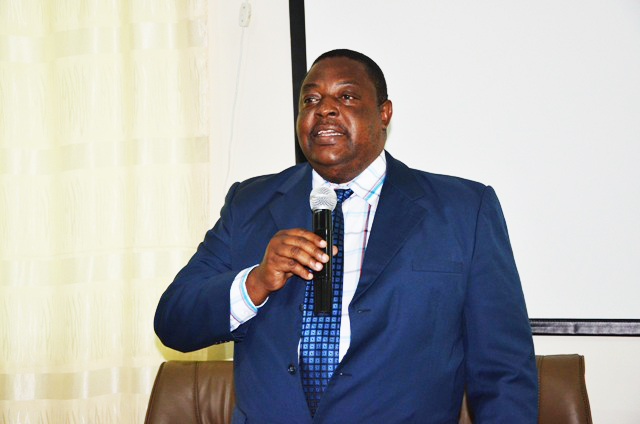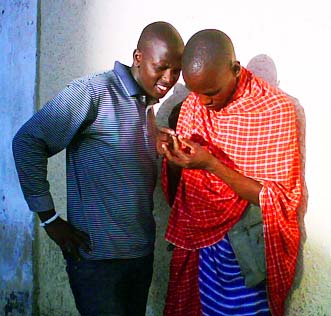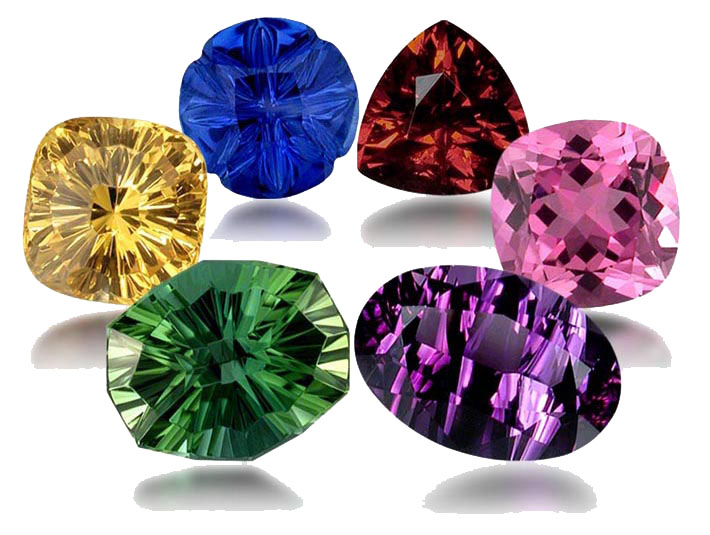By TZ Business News Staff.
The Tanzania Government has confirmed the TZ Business News report Tanzanite gemstones are being smuggled out of the country in alarmingly large quantities.
In two separate reports in early 2014, this website said large scale smuggling was being made possible through the collaboration of corrupt Tanzania Revenue Authority officers and licenced mineral dealers. The contribution of mineral brokers toward Tanzanite smuggling was insignificant.
The Government said in a statement published in the government owned Daily News last month gemstones from Tanzania worth Tsh. 635 billion were being smuggled out of the country annually through illegal channels, ending up in either Kenya or India.
The Commissioner for Minerals in the Ministry of Energy and Minerals, Engineer Paul Masanja, stated in Arusha in November 2014 Kenya imports Tanzanite valued at USD 100 million per year while India imports USD 300 million worth of the blue stone. Official records in Tanzania show Tanzania exports only USD 38 million US dollars per annum, he said.
“This exactly means that Tanzanite valued at 382 million US dollars is taken out of the country every year while the state remains to earn only about 38 million US dollars of that, which is equivalent to only 20 per cent of the total blue gemstones being mined from the Mirerani Hills,” Masanja said.
This Website reported earlier this year the Arusha-based Northern Zonal Mines Officer in the Ministry of Energy and Minerals, Benjamin Mchwampaka had expressed concern ‘unspecified amounts’ of Tanzanite was being smuggled out of the country through unofficial, unmanageable, unnoticeable syndicates.
Mchwampaka pointed a finger to one particular group in the Tanzanite value chain as being especially responsible for these syndicates: mineral brokers, but others during the investigation pointed a finger at mineral dealers.
The Deputy Minister for Energy and Minerals Stephen Masele had conceded government revenue from Tanzanite and other gemstones was threatened by smuggling. He was however not able to provide figures to show the extent of this problem. The Zonal Mines Officer was also not able to provide figures to show the extent of the problem–which left room for speculation.
The Tanzanian journalist Sebastian Paschal Sanga conducted research in 2007 for the European Open Society Institute and concluded one financial year Tanzania had received only USD 12 million out of nearly USD 500 million of the Tanzanite traded on the world market that year, and that a big chunk of Tanzanite is smuggled to India through Nairobi, Kenya.
Pointing the accusing finger to mineral brokers, Mchwampaka said there were two types of traders on the Tanzanite value chain. ‘Dealer’ license holders and ‘broker’ license holders. Dealers have permission to own mines, to purchase Tanzanite from other dealers, to purchase from brokers and to export the mineral. Mchwampaka provided me a list of 98 licensed mineral dealers for the year 2013/14.
Brokers, on the other hand, are licensed to purchase Tanzanites from miners or from other sources, but only for local resale to dealers or among themselves. They are not allowed to export. Mchwampaka provided me a list of 161 licensed brokers but said this list was not representative of the number of brokers working in Arusha and other parts of the country. Arusha was packed with unlicensed Tanzanite brokers collecting stones and smuggling them out of the country, he said.
“Go see the unlicensed Tanzanite brokers at St. Thomas street in downtown Arusha if you have time,” the Zonal Mines Officer said. “We want them to get licensed but there is no response at all. These are the smugglers of Tanzanite denying this country proper revenue from this gemstone. The dealers are clean people. We know what they are doing and we can monitor them.”
St. Thomas street is teeming with people almost each day of the week. On this particular day of my interviews there, most people—the brockers–are Maasai men. They are dressed in bright red Maasai clothes, some holding sticks in their hands. Others are pinned to pavement walls discussing Tanzanite between themselves and between them and people dressed in attire not Maasai.
With the help of a guide, a broker who identifies himself as Adolf Andrew agrees to talk about Tanzanite smuggling and broker licenses. “Yes, I know the Government wants us to get licensed, but we have refused to get licensed….get licenses for what! …for being jobless? For being on the streets? Sikiliza ndugu, we are not getting licensed, and we are not getting out of St. Thomas either,” Adolf snaps.
“Tanzanite is our stone,” he says. “The Government has brought foreigners to mine this gemstone and we are rendered jobless. I have looked for a job at Tanzanite One for six years, but no success. You have to know the President’s son or Mr. Ame Mpungwe to get employment at the Mererani Tanzanite Mine. What you see here at St. Thomas is a struggle to survive. Do I look like I have the capital to buy even one kilo of Tanzanite for smuggling to Kenya, or Thailand, or South Africa? Tanzanite smuggling is done by big people with capital. It’s a collusion between Dealers and government officials in Customs and the Tanzania Revenue Authority.
Explaining how this collusion works, the unlicensed broker says the small brokers like him buy low quality Tanzanite (nick named MAGONGA) and send it to one of two resale locations. Magonga is whisked away from mining pits by dishonest mine workers at Merelani. Sometimes good Tanzanite gets stolen from the mines, but that is the exception, Adolf says. The dishonest mine workers are interested in quick money, so the price is low. “We buy that and re-sale it to bigger companies in Arusha. This is the kind of Tanzanite small brokers are exposed to at St. Thomas area in downtown Arusha or at a Tanzanite market at Mererani called Kijiji—another place flooded with brokers.
“You do not find Magonga on display in India, in South Africa, In Thailand, in Hong Kong or America; you find high quality Tanzanite there,” Adolf argues.”So who gets all that high quality Tanzanite in all those places? It is the big dealers who get it there. They have the money to get it, they have the money to corrupt government officials for permits to get it out.”
Adolph says the big dealers buy the low quality Tanzanite from the little brokers and pack it with the high quality Tanzanite then take it to government offices for declaration; but they declared the parcels as low grade Tanzanite to avoid Tax. The Tanzanite is packed in such a way that displays magonga first, hiding good Tanzanite to avoid Taxes.
In this way high grade Tanzanite is smuggled out through normal export routes without paying the correct taxes. Big dealers allegedly pay Customs and TRA officials bribes so that they do not see the correct values.
Tanzania Mineral Dealers Association (TAMIDA) Chairman, Sammy Mollel commented on the 2007 Open Society Institute research findings which claimed Tanzania had received only USD 12 million out of nearly USD 500 million of the Tanzanite traded on the world market in one year at one point, and that a big chunk of the gemstone is smuggled to India through Nairobi, Kenya.
“No licensed Mineral dealer smuggles any Tanzanite out this country. We all do clean, verifiable business and we pay all due taxes,” Mollel said in an interview in Arusha. “The difference you see in revenue in Tanzania when you compare to Tanzanite values outside the country has to do with value addition. The Tanzanite you find outside this country has been value added. The $12 million Tanzanite you saw here is the same Tanzanite you find valued at $500 million outside the country after value addition.” Value addition refers to selling processed Tanzanite instead of raw Tanzanite the country exports.
But Kenya concedes Tanzanite is smuggled in from Tanzania and the sister East African state have agreed to harmonize their gemstone tax laws with Tanzania’s in order to reduce the Tanzanite smuggling incentive which has encouraged traders to evade the taxes in Tanzania in favour of Kenya, according to the Permanent Secretary in the Ministry of Energy and Minerals Eliakim Maswi. The harmonization process has reached an advanced stage, Maswi told journalists in November.
In 2007 Sanga found out Kenya and India were both Tanzanite exporters on the world market, although Tanzania is the only Tanzanite producer in the world. He also identified two tribes as being facilitators of Tanzanite smuggling from Tanzania to Kenya: The Maasai and Luo tribes of East Africa who enjoy belonging to both sides of the Kenya-Tanzania border, with families on both sides.
Tanzania Minerals Audit Agency (TMAA) is in the meantime busy fighting mineral smuggling, which some officials in the agency have described as rampant, with little hope for immediate success because of lack of sufficient personnel in the agency.
“We have 350 known minerals smuggling routes,” Yisambi Shiwa, the TMAA communications officer said in an interview. “We have only 82 members of staff. It is not possible to man all these smuggling routes even if we all left our offices to go out there to man the smuggling routes. We need additional staff.”
Eight cases of Tanzanite smuggling were identified and action taken between July 2012 and October 2013, according information made available. TMAA started its on-going anti mineral smuggling in July 2012.
A Chinese national was nabbed attempting to smuggle Tanzanite through Julius Nyerere International Airport (JNIA) on November 4th, 2012. He was ordered to pay the required taxes, he complied and was allowed to continue with his trip to China. On December 8th, 2012, Another Chinese National, Fung Jung, was caught attempting to smuggle Tanzanite through Kilimanjaro International Airport (KIA). He allegedly asked to be set free on condition that he leaves the Tanzanite back, and that he would return to pay the required taxes. He was set free leaving the Tanzanite back but has not returned to claim his gemstones.
A Tanzanian national named Salha Islam Sahaag was caught on February 18th, 2013 attempting to smuggle Tanzanite through KIA masked as wrist watches, ear rings, necklaces. The suspect was ordered to pay requisite taxes and was allowed to travel with the gemstones after complying. Two suspects were nabbed attempting to smuggle Tanzanite at KIA on March 16 and March 19, 2013. One suspect, a Chinese national named Yang Jie had stashed Tanzanite in a check-in bag while the other suspect, an Indian National named Chaudhari Jayantil using passport number Z031715. The two suspects were allowed to continue with their journey after their Tanzanite was confiscated and nationalized. A South African national named Rian Gouws was caught attempting to smuggle Tanzanite though JNIA on April 4th 2013. Circumstances of his release from the JNIA police station have not been made clear, although records do indicated a smuggling case was files for him bearing file number JNIA/IR/120/2013.
On May 28th, 2013, Khadija Juma Sabatele, a Tanzanian national was caught attempting to smuggle Tanzanite valued at Tsh. 55.0 million/- through JNIA. Khadija is a licensed mineral dealer but was carrying a dealer’s license which expired on June 30, 2012. She produced receipts showing she had paid for license renewal and was charged taxes amounting to Tsh. 552,900/- and then allowed to proceed with her trip. Read earlier stories here and http://www.tzbusinessnews.com/tanzania-anti-minerals-smuggling-failure/






